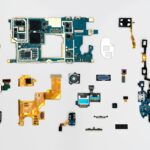
Introduction
What is a Circuit?
A circuit is a closed path through which electricity flows. Think of it like a racetrack where electric current can travel. It consists of various components that work together to perform a specific function, such as lighting a bulb or powering a motor.
Importance of Building Circuits
Building circuits is crucial for several reasons:
- Understanding Fundamentals: It helps to grasp fundamental electronic principles.
- Practical Application: Provides hands-on experience with real-world applications.
- Innovation: Encourages creativity to solve problems or build new devices.
For instance, when I built my first circuit to light up an LED, it ignited a passion for electronics, demonstrating the tangible impact of circuit construction.

Basics of Circuits
Understanding Electrical Current
Electrical current is the flow of electric charge through a circuit, similar to water flowing through a pipe. It is measured in amperes (A) and is fundamental for any electrical device to function.
Voltage and Resistance in Circuits
Voltage, measured in volts (V), is the force that pushes the current through the circuit. Resistance, in ohms (Ω), opposes this flow. The interaction of these two is defined by Ohm’s Law:
- Ohm’s Law: ( V = I times R )
Components Needed for a Simple Circuit
To build a basic circuit, you typically need a few essential components:
- Battery (Power Source)
- Wires (Connections)
- Load (e.g., Light Bulb)
- Switch (Control)
From my experience, laying out these components on a breadboard for the first time was like setting the stage for an electrifying performance!

Building Your First Circuit
Choosing a Power Source
The first step in building your circuit is selecting a power source. Common options include batteries or power adapters. For beginners, a simple 9V battery is often ideal. It’s portable and easy to work with!
Connecting Components
Once you have your power source, it’s time to connect the components. Use copper wires to join your battery, load, and any switches. Remember:
- Red Wire: Positive connection
- Black Wire: Negative connection
Testing Your Circuit
After connecting everything, it’s time to test your circuit. Simply flip the switch or connect the battery—if everything is in place, your light should illuminate!
When I built my first circuit, the excitement of seeing it work was exhilarating, proving just how rewarding this hands-on learning can be!

Troubleshooting Common Issues
Identifying Loose Connections
As you build your circuit, you may occasionally encounter issues with loose connections. These can prevent electricity from flowing smoothly. A quick visual inspection can help identify problems—look for wires that aren’t securely connected. Gently tug on each wire to ensure they are properly seated.
Dealing with Burnt Components
If your circuit doesn’t work and you notice a burnt smell or visual damage, one of your components may have burned out. Components like resistors and LEDs can fail if overloaded. Replace the burnt part, and be sure to check the circuit’s power levels to avoid a repeat issue.
Checking for Short Circuits
Short circuits occur when electricity finds an unintended path, often causing components to fail. If your circuit behaves unpredictably, check for exposed wires that may be causing the short. I once had to meticulously trace my circuit back to find a single wire creating chaos—it was a valuable learning experience!

Enhancing Your Circuit
Adding Switches
To make your circuit more user-friendly, consider adding a switch. This simple addition allows you to control when your circuit is on or off, providing convenience and safety. You can use a basic toggle switch or a push-button switch, depending on your preference.
Using Different Components
Experimenting with various components can also enhance your circuit. Try integrating:
- Resistors: To control current flow
- Capacitors: For energy storage and smoothing
- Transistors: For amplifying signals
Experimenting with Circuit Designs
Once you’re comfortable, don’t hesitate to play with circuit designs. Create parallel and series circuits, or even make a simple alarm system. When I first experimented with different designs, I found joy in the creative process, sparking new projects!

Safety Precautions and Best Practices
Handling Electrical Components Safely
Safety is paramount when working with electrical components. Always ensure you’re working in a dry area and wear insulated gloves when handling live wires. Additionally, avoid touching exposed connections while the circuit is powered.
Proper Circuit Disposal
When you’re finished with a project, proper disposal of electrical components is essential. Many local electronics stores or recycling centers accept old components. This not only protects the environment but also keeps unnecessary waste out of landfills.
Safety Measures for Working with Electricity
Here are some basic safety measures:
- Always disconnect power before making adjustments.
- Use a multimeter to check for live voltage before touching components.
Resources for Further Learning
For those looking to deepen their understanding, many resources are available:
- Books: “Make: Electronics” by Charles Platt
- Online Courses: Sites like Coursera and Udemy offer excellent courses.
- Community Workshops: Check out local maker spaces for hands-on learning.
Reflecting on my own learning journey, these resources greatly enhanced my skills and confidence in electronics!






